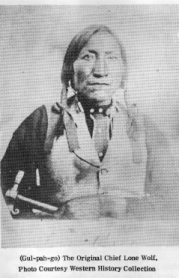GUL PAH GO (Lone Wolf I)

Gul-Pah-go became head chief of the Kiowa after the death of Do ha son in 1866 and remained as head chief until his death in 1879. He was known to the white people as Lone Wolf
In the fall of 1873, Tau-ah-kia , nineteen year old son of the hereditary chief of the Kiowas, and his close friend, Young Sitting Bear, son of Set-angya (Satank) and a number of young men left on a raid into Mexico. The waiting time for the two favorite sons to return was long, 5 moons. News didn't reach the Kiowa camp near Devil's Canyon until January 13, 1874, when the young men rode back into camp with their faces painted black. The two sons were not with them.
On December 3, 1873, Tau-ah-kia was killed in south Texas by a Lieutenant Hudson of Fort Clark, Texas who was a member of the 4th Calvary. Fort Clark had been alerted that a band of Kiowas and a few Comanches were on their way back from a Mexico war party. A detachment of the 4th Calvary was sent out to intercept them.
Riding with the war party was his boyhood friend, Momaday, who retrieved his fallen friend and buried him according to Kiowa custom. When a young Kiowa Brave died in battle, he was buried on the battle spot.
The news spread through the camp and wailing pierced the air, mourning a chief's death. Tau-ah-kia's family tipi was torn down, family horses killed and belongings burned. The old chief, Lone Wolf and Setting Bear, sat in the tipi for 4 days without eating or drinking. Then they got up and came out, looking llike old, old men with their faces fallen into the bones and their eyes pushed into the backs of their heads.
The summer of 1874, Lone Wolf, the acknowledged leader of the war element of the Kiowa lead a party to Mexico to bury the boys, making a vow to kill a white man in retaliation. This created more of the outbreak of hostilities in 1874-1875 with the Kiowa, Comanches, and Cheyenne.
As the hostilities ended, in May 1875, 9 Comanche, 26 Kiowa and 35 Cheyenne and Arapahowere sent to Military Prison in Fort Marion, Florida The most prominent Kiowa included were Lone Wolf, Swan, Woman Heart, and White Horse. They were released and returned home, May 1878. Shortly after his return, Lone Wolf conferred his name and succession upon hi adoted son, Mom'a'date, the friend who had been with his son when he was killed. Lone Wolf died in 1879 and is buried in an unmarked grave on the north side of Long Horn Mountain east of Kiowa County.